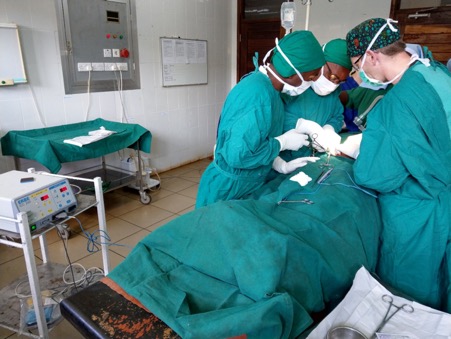The Affordable Mesh Hernia Surgery Initiative
The key principle underpinning our projects is the empowerment of local expertise through education, training, development of infrastructure and collaboration.
Hernia Repair
Hernia surgery is the most common general surgical procedure performed worldwide. In Tanzania there are an estimated 800,000-1million hernias requiring treatment currently.
Using Mesh
This project adopts a well-established procedure using a mesh prosthesis (implant) for hernia repair. This is in contrast to the current practice in most LMICs (low and middle income countries), where the prohibitive cost of mesh means that when surgery is undertaken, a traditional suture plication technique is the only option available. This Initiative offers the opportunity for for countries such as Tanzania to emulate the same gold standard for hernia repair as practiced by the UK (and other leading world healthcare providers) for the last 30 years. And in a cost neutral way.
If every hernia was repaired today in Tanzania with mesh, in 5 years there would be 4,000-8,000 recurrences, rather than 160,000-320,000 with a suture repair.
Despite the well-recognised benefits of using mesh for such surgery, procedures using mesh in LMICs are rare with the cost of mesh being prohibitive for most of the population. For example, the costs of inguinal hernia repair in Tanzania ranges from perhaps 50k TZS ($21 USD) in some smaller centres, up to 600k TZS ($245 USD) in some of the larger centres. To use a commercial mesh adds a further 250k-350k TZS ($102-$143 USD) to the price, which is prohibitive for most. Furthermore, as mesh is only rarely used, expertise in this technique is thus also limited.

There is a novel approach to mesh surgery, that was developed and pioneered in India and subsequently adopted and rigorously tested by the UK based charitable organisation Hernia International (they have repaired over 20,000 hernias worldwide with this material). This uses a very particular form of ‘mosquito netting’ (which has comparable composition to standard commercial mesh) for the prosthesis. This material has been rigorously tested to ensure its comparability, with the results published in the medical literature . By reducing the cost of the mesh to almost zero (once some basic infrastructure is in place), it thus opens up the opportunity of revolutionising hernia surgery in LMICs.
It is widely accepted that the use of mesh for hernia repair is a far superior technique with lower complication rates – most notably recurrence rates of just 0.5-1% versus 20-40%. This means that for every two hundred hernias repaired with mesh only one or possibly two will recur, whereas with a sutured repair 40-80 will recur. Or in other words, if every hernia was repaired today in Tanzania with mesh, in 5 years there would be 4,000-8,000 recurrences, rather than 160,000-320,000 with a suture repair. Consequently, the financial and clinical impact of this speaks for itself.
Running the Project
The approach of this project is one of collaboration. In Tanzania, SWIFTSS and the TSA (Tanzania Surgical Association) work very closely together to ensure success. Whilst conceived and proposed by SWIFTSS, the project is considered a TSA-owned and led project within Tanzania.
Consequently, it is aligned with the aims and aspirations of the Tanzanian Government, as described in the Tanzania Development Vision 2025, in becoming a self-sufficient and sustainable country, not suffering from ‘donor-dependence syndrome’, and with a focus on high quality livelihoods which can only be achieved through good health.
The global burden of surgically preventable disease is now greater than that of HIV, Malaria and TB combined.
Its about more than ‘just’ hernias though
Transforming hernia repair is, in its own right, an admirable objective. However, the approach of this project (reflecting the methodology of SWIFTSS as an organisation) is far more holistic. It is about improving surgical care as a whole which, as the Lancet Commission on Global Surgery has highlighted, is very much needed. The global burden of surgically preventable disease is now greater than that of HIV, Malaria and TB combined.
Using the ‘vehicle’ of hernia repair, this project looks to address much more – including; basic surgical infrastructure and equipment, surgical skills, surgical pathways, safer surgery principles, teamworking, collaboration, quality assurance processes, audit, research, education, and partnerships (local, national and international). And to do this all in an affordable and sustainable way.
Beyond Hernia Surgery
The vision of SWIFTSS is that the principles of the Affordable Mesh Hernia Surgery Initiative could be applied to other surgical procedures in the future, with processes and procedures such as training, procurement and logistics already in place. Furthermore, as we are now seeing, the early successes of this methodology in Tanzania has generated interest from other countries. We now have an established workstream in Sierra Leone and are in the development phase of projects in several other countries.
The Sustainable Development Goals (SDGs), also known as the Global Goals, were adopted by all United Nations Member States in 2015 as a universal call to action to end poverty, protect the planet and ensure that all people enjoy peace and prosperity by 2030.
Global Goal 1 – No Poverty
With the greatly reduced recurrence rates of hernia related-problems and reduced stay in hospital per operation, patients can regain and maintain their full health, minimising impact on their ability to work and support their families.
Global Goal 3 – Good health and well-being
Needless to say, this project directly addresses this goal. Not only will it reduce the number of hernias requiring treatment, in the long term it will enable more capacity for surgical services to develop in other ways.
Global Goal 4 – Quality Education
The fundamental thread underpinning this project is to train the trainers, whereby local surgeons are trained to a standard where they are self-sufficient and can in turn train others.
Global Goal 8: Decent work and economic growth
By reducing the number of people burdened with hernias and helping them return to work, the project will boost the economy and promote full and productive employment.
Global Goal 17 – Partnerships for the goals
The success of this project is grounded in the high quality collaborative relationships that SWIFTSS enjoys with our local partners.
